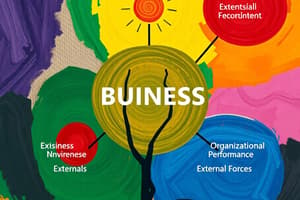Podcast
Questions and Answers
What does environmental uncertainty encompass in an organization’s context?
What does environmental uncertainty encompass in an organization’s context?
- The economic growth rate and inflation
- The political regulations and stability
- The demographic characteristics of the population
- The degree of change and complexity in the environment (correct)
Which of the following is NOT part of the general environment impacting organizations?
Which of the following is NOT part of the general environment impacting organizations?
- Political and legal factors
- Customer preferences (correct)
- Economic factors
- Technological factors
Which force is concerned with population characteristics affecting business operations?
Which force is concerned with population characteristics affecting business operations?
- Socio-cultural
- Demographic (correct)
- International
- Technological
What does the technological environment include?
What does the technological environment include?
In a PESTEL analysis, what aspect of the environment includes issues like pollution and sustainable energy?
In a PESTEL analysis, what aspect of the environment includes issues like pollution and sustainable energy?
What is the significance of understanding the competitive environment for an organization?
What is the significance of understanding the competitive environment for an organization?
Which of the following does NOT contribute to the complexity of an organization’s environment?
Which of the following does NOT contribute to the complexity of an organization’s environment?
Which factor would be analyzed under the political and legal aspect of the PESTEL framework?
Which factor would be analyzed under the political and legal aspect of the PESTEL framework?
Which of the following factors does not indicate a higher intensity of rivalry among competitors?
Which of the following factors does not indicate a higher intensity of rivalry among competitors?
What is a characteristic of a strong organizational culture?
What is a characteristic of a strong organizational culture?
Which element is a component of the bargaining power of buyers?
Which element is a component of the bargaining power of buyers?
In Porter's five forces model, what does a high threat of substitutes indicate?
In Porter's five forces model, what does a high threat of substitutes indicate?
Which of the following dimensions of organizational culture emphasizes the importance of teamwork?
Which of the following dimensions of organizational culture emphasizes the importance of teamwork?
What type of stakeholders are suppliers classified as?
What type of stakeholders are suppliers classified as?
Which of the following is a common barrier to entry that can protect industry profits?
Which of the following is a common barrier to entry that can protect industry profits?
Which visible artifact is likely to represent an organization's culture?
Which visible artifact is likely to represent an organization's culture?
Which aspect is crucial for the maintenance of an organization's culture after it is established?
Which aspect is crucial for the maintenance of an organization's culture after it is established?
Which of the following is least likely to be a reason for varying levels of bargaining power among suppliers?
Which of the following is least likely to be a reason for varying levels of bargaining power among suppliers?
Which of the following represents a primary claim of stockholders in a company?
Which of the following represents a primary claim of stockholders in a company?
How can organizational culture be best influenced according to its origin?
How can organizational culture be best influenced according to its origin?
Which of the following is an example of an internal stakeholder?
Which of the following is an example of an internal stakeholder?
Flashcards
Business Environment
Business Environment
The factors outside an organization that can affect its performance. Examples include economic conditions, technology, and government regulations.
Environmental Uncertainty
Environmental Uncertainty
The degree to which an organization's environment is predictable and stable.
Economic Forces
Economic Forces
The general economic situation, including factors like interest rates, inflation, and unemployment.
Technological Forces
Technological Forces
Signup and view all the flashcards
Political and Legal Forces
Political and Legal Forces
Signup and view all the flashcards
Socio-cultural Forces
Socio-cultural Forces
Signup and view all the flashcards
Competitive Environment
Competitive Environment
Signup and view all the flashcards
PESTEL Analysis
PESTEL Analysis
Signup and view all the flashcards
Suppliers
Suppliers
Signup and view all the flashcards
Distributors
Distributors
Signup and view all the flashcards
Customers
Customers
Signup and view all the flashcards
Competitors
Competitors
Signup and view all the flashcards
Porter's Five Forces Model
Porter's Five Forces Model
Signup and view all the flashcards
Rivalry Among Competitors
Rivalry Among Competitors
Signup and view all the flashcards
Barriers to Entry
Barriers to Entry
Signup and view all the flashcards
Bargaining Power of Suppliers
Bargaining Power of Suppliers
Signup and view all the flashcards
Bargaining Power of Buyers
Bargaining Power of Buyers
Signup and view all the flashcards
Threat of Substitutes
Threat of Substitutes
Signup and view all the flashcards
Organizational Culture
Organizational Culture
Signup and view all the flashcards
Strong Culture
Strong Culture
Signup and view all the flashcards
Weak Culture
Weak Culture
Signup and view all the flashcards
Stakeholders
Stakeholders
Signup and view all the flashcards
Study Notes
Business Environment
- Environment encompasses external institutions influencing organizational performance.
- Environmental uncertainty varies across environments, defined by change and complexity. Degree of change refers to frequency of components' alteration. Complexity refers to the number of components and the understanding of them by the organization.
General Environment
- General environment impacts all organizations, including political, economic, socio-cultural, technological, environmental, and legal factors.
- Economic factors include interest rates, inflation, unemployment, and economic growth.
- Technological factors encompass existing infrastructure, technological advancements, and innovations impacting goods/service production and distribution.
- Political and legal factors refer to political conditions, government regulations, and legal changes.
- Socio-cultural factors include customs, values, traditions, lifestyles, beliefs, and behavior patterns.
- Demographic factors involve characteristics of the population (age, gender, ethnicity, race, sexual orientation, social class).
- Environmental factors include pollution effects, sustainable energy use, and climate change.
- International factors reflect an organization's involvement or impact from global business practices.
- An international PESTEL analysis focuses on political stability, patent policy, growth rates, cultural attitudes, technology, environmental factors, and legal frameworks.
Competitive Environment
- Competitive environment influences how an organization acquires inputs and sells outputs, stemming from suppliers, distributors, customers, and competitors.
- Suppliers provide needed input resources.
- Distributors facilitate sales to customers.
- Customers purchase the produced goods/services.
- Competitors offer similar goods/services.
Porter's Five Forces
- Analyzing industry attractiveness using Porter's Five Forces. Higher rivalry lowers industry attractiveness and profitability.
- Rivalry among competitors: factors include number of competitors, demand growth, product differentiation, and exit barriers. Stagnant/decreasing demand increases rivalry.
- Threat of new entrants: Industry attractiveness diminishes with lower entry barriers (capital investment, economies of scale, licenses, customer loyalty).
- Bargaining power of suppliers: Higher supplier power reduces industry profits, depending on supplier count, customer purchase frequency, supplier expansion potential, and switching costs for customers.
- Bargaining power of buyers: Higher buyer power reduces industry profits.
- Threat of substitutes: Similar products/services from other industries posing a threat.
Organizational Culture
- Organizational culture is shared values, principles, traditions, and behaviors distinguishing an organization.
- Strong cultures connect behaviors to widely shared values and strongly identified employee culture.
- Weak cultures have limited top management values, lacking employee identification and possibly conveying contradictory messages.
- Culture levels include visible artifacts (observed behavior, dress, symbols, ceremonies, office design); invisible values/beliefs (interpreted from stories and language); and underlying assumptions/deep beliefs (guiding subconscious behavior, role modeling, legends).
- Cultural dimensions include adaptability, attention to detail, outcome orientation, people orientation, team orientation, and integrity.
- Establishing culture involves founder vision, transmission through stories/symbols/language, and maintenance via employee selection/socialization. Top management greatly influences culture.
Stakeholders
- Stakeholders are individuals or groups with interests in a company.
- External stakeholders include customers, suppliers, creditors, governments, unions, communities, and the general public.
- Internal stakeholders include stockholders, employees, managers, senior executives, and board members.
- Stakeholders' claims vary. Stockholders seek return on investment; managers prioritize stakeholder benefit and resource efficiency; employees seek rewards; suppliers seek fair/prompt payment; distributors seek quality/agreed prices; customers are essential for business survival; and communities provide operational infrastructure.
Studying That Suits You
Use AI to generate personalized quizzes and flashcards to suit your learning preferences.




